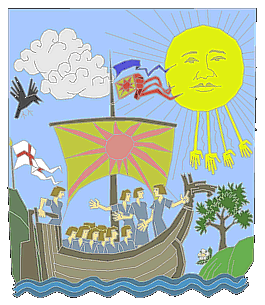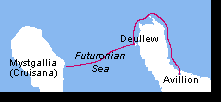EDRANNASHAN
One day, almost 8,000 years ago, someone decided to leave a mark to posterity, and thus giving us a view of the way the world was looked upon, and a glimpse of the way of life all those centuries ago. In a cave near the hamlet of Edrannashan, in Hd Highmond, Suthershire this someone covered the walls with very vivid paintings of people, animals and symbols, possibly religious, revealing an imagination of amazing depth. This is so far the oldest sign that has been found of human activity on the northwestern peninsula of the Old Continent. Seeing that all other antiquities are of a later date it's probable that the land was occupied by people coming from the south, over the Angel mountains, making Edrannashan one of the first stops on the way. If these people were the Estron or if they came later to dominate an earlier settlement of people is something we will probably never know. We can only speculate, basing our guesses on the artefacts, mounds, stone circles and other traces of human inhabitation and activities found all over the peninsula. What we with some certainty do know is that the Estron were in full control of the land about 1,800 years ago, when the Somerish arrived from Mystgallia. Written sources from the period before that are very few, and to the most part limited to stone carvings of which some still defy interpretation, and most texts describing its history in more detail have been written down centuries later.
THE GREAT DEPARTURE
 Some time around 1400 BP there was a dramatic change in the religious climate in Mystgallia, present day Christiana. Cruis, a founder of a new religion demanding the unconditional abandonment of all other gods, had begun his teachings and this in such an convincing way that soon an overwhelming number of people on the island had embraced this new faith. With the number of followers increasing an equally increasing pressure was put upon those who wished to remain within the ancient religious framework of their forefathers. The most significant group of these opponents to the new religion was the so called Summer clan, sometimes referred to as the Fifth clan of Mystgallia. Worshipping the sun god Leoma as their singular deity they were the odd man out among the clans, and were to become even more so as the new religion won an ever greater part of the population. Eventually there was too great a pressure on the clan to convert, which left them, basically, with two options, staying and converting, or leaving. A small number chose to give in to the demands and to accept the new faith, while the majority, under the leadership of its legendary charismatic leader, Begimend Sunnanwine, decided to search for new lands where they could freely follow their old traditions. According to old Summer clan legends there was a mythical continent, known as the Summer Lands, beyond the eastern seas, the home of their god, the sun, which he left every morning to watch over his creation. In their exposed situation people of the clan began considering the events a sign to search for that land, to find what they increasingly felt was their true home. Some time around 1400 BP there was a dramatic change in the religious climate in Mystgallia, present day Christiana. Cruis, a founder of a new religion demanding the unconditional abandonment of all other gods, had begun his teachings and this in such an convincing way that soon an overwhelming number of people on the island had embraced this new faith. With the number of followers increasing an equally increasing pressure was put upon those who wished to remain within the ancient religious framework of their forefathers. The most significant group of these opponents to the new religion was the so called Summer clan, sometimes referred to as the Fifth clan of Mystgallia. Worshipping the sun god Leoma as their singular deity they were the odd man out among the clans, and were to become even more so as the new religion won an ever greater part of the population. Eventually there was too great a pressure on the clan to convert, which left them, basically, with two options, staying and converting, or leaving. A small number chose to give in to the demands and to accept the new faith, while the majority, under the leadership of its legendary charismatic leader, Begimend Sunnanwine, decided to search for new lands where they could freely follow their old traditions. According to old Summer clan legends there was a mythical continent, known as the Summer Lands, beyond the eastern seas, the home of their god, the sun, which he left every morning to watch over his creation. In their exposed situation people of the clan began considering the events a sign to search for that land, to find what they increasingly felt was their true home.
THE GREAT VOYAGE
 Although some legends may tell you differently the great migration of the Summer clan probably wasn't one singular event, a voyage including all the members of the clan. It's more likely that it happened in waves, as told in Aewil Arweorlic's "History of the Somerish people", starting with a group, possibly guided by the supposedly godinspired leader Begimend Sunnanwine, who, when new land was indeed found, sent a message back telling the good news, inspiring other groups to follow, until eventually practically all the people belonging to the clan had left Mystgallia, at least those who were faithful to their old ways. A multitude of legends are connected with this voyage, and most of them have some kind of supernatural ingredient. Among the most popular ones we find the story of the evil ocean spirits or seafivels trying, with various tricks, to prevent the seafarers from reaching their destination, the battle with the sea monster WŠlgenga, and the speaking dolphins sent by the sun god to guide the seafarers on their perilous quest.
Although some legends may tell you differently the great migration of the Summer clan probably wasn't one singular event, a voyage including all the members of the clan. It's more likely that it happened in waves, as told in Aewil Arweorlic's "History of the Somerish people", starting with a group, possibly guided by the supposedly godinspired leader Begimend Sunnanwine, who, when new land was indeed found, sent a message back telling the good news, inspiring other groups to follow, until eventually practically all the people belonging to the clan had left Mystgallia, at least those who were faithful to their old ways. A multitude of legends are connected with this voyage, and most of them have some kind of supernatural ingredient. Among the most popular ones we find the story of the evil ocean spirits or seafivels trying, with various tricks, to prevent the seafarers from reaching their destination, the battle with the sea monster WŠlgenga, and the speaking dolphins sent by the sun god to guide the seafarers on their perilous quest.
DEULLEW
 The first land that was sighted, according to the legend, was Enys Melyn, i.e. the Isle of Milne, where the clan for the first time met the Estron. They were greeted in a friendly way, and symbolic gifts were exchanged. The clan became aware that also this people worshipped the sun, and this convinced them that they had found what they were looking for. The island was at that time part of the Estron kingdom of Deullew, whose name still lives on in the lathe of Daylowe. Its main settlement was Tregwellt which was situated near what is now Strawton, where the possible traces of the foundations can still be seen. Here the newcomers were greeted and welcomed by king Ierll and his court. They were shown much hospitality, but when the king became aware of their intentions to settle down in his land, he was worried, and spoke of fairer lands which they would find if they travelled to Avillion, and Trefwyn Uchel, the seat of the High King Brennan. They were told through sign language, and similar ways, how to get there, and as they travelled north to pass Breightlith Gore a messenger was sent back to Mystgallia to tell their kin about what they had found.
The first land that was sighted, according to the legend, was Enys Melyn, i.e. the Isle of Milne, where the clan for the first time met the Estron. They were greeted in a friendly way, and symbolic gifts were exchanged. The clan became aware that also this people worshipped the sun, and this convinced them that they had found what they were looking for. The island was at that time part of the Estron kingdom of Deullew, whose name still lives on in the lathe of Daylowe. Its main settlement was Tregwellt which was situated near what is now Strawton, where the possible traces of the foundations can still be seen. Here the newcomers were greeted and welcomed by king Ierll and his court. They were shown much hospitality, but when the king became aware of their intentions to settle down in his land, he was worried, and spoke of fairer lands which they would find if they travelled to Avillion, and Trefwyn Uchel, the seat of the High King Brennan. They were told through sign language, and similar ways, how to get there, and as they travelled north to pass Breightlith Gore a messenger was sent back to Mystgallia to tell their kin about what they had found.
AVILLION
 The ships passed through the Orcadion Archipelago and followed the coast where it turned south, here and there watched by the curious eyes of the local people. Several days passed and some people started talking about having been fooled by the king, and wanted to go ashore at the next suitable place, and settle there, but Begimend urged them on, himself wanting to see what Ierll had been telling him about. Finally they reached what is now Sibury Firth and here they were met by a ship whose captain, after learning their business, welcomed them and offered to guide them to Trefwyn Uchel (today's Trevenill, near Bridglea), which Begimend and his people accepted. They followed the Estron ship up the river until they reached the king's city. Begimend and his closest men were brought to the king who welcomed them. When he heard the reason for their arrival he and the people of Trefwyn Uchel showed them hospitality, as brothers in the worship of the sun, and took them into their homes, awaiting a decision of the king's council.
The ships passed through the Orcadion Archipelago and followed the coast where it turned south, here and there watched by the curious eyes of the local people. Several days passed and some people started talking about having been fooled by the king, and wanted to go ashore at the next suitable place, and settle there, but Begimend urged them on, himself wanting to see what Ierll had been telling him about. Finally they reached what is now Sibury Firth and here they were met by a ship whose captain, after learning their business, welcomed them and offered to guide them to Trefwyn Uchel (today's Trevenill, near Bridglea), which Begimend and his people accepted. They followed the Estron ship up the river until they reached the king's city. Begimend and his closest men were brought to the king who welcomed them. When he heard the reason for their arrival he and the people of Trefwyn Uchel showed them hospitality, as brothers in the worship of the sun, and took them into their homes, awaiting a decision of the king's council.
SETTLEMENT
After a few days of discussion the council decided to provide the newcomers with help and guidance as to where they could settle down further up the river and they also agreed that there would be room also for the expected clan members arriving from Mystgallia. After a month or two more of the clan ships with eager new settlers started arriving, and all were welcomed. The Estron and the Summer clan lived side by side in harmony and peace for a long time.
CONFLICT
The main cause of what was to come could probably partly be blamed on the difference in birth rate between the two peoples. Traditionally the Clan had big families, while the Estron had considerably smaller ones. As time passed it came to a point where the Clan all but outnumbered the Estron in Avillion, and this caused distress among some groups who complained to the king, who disregarded this as a point of less importance, and reassured the people that this was not a problem.This did not satisfy them, and soon unfounded rumours of the Clan started spreading among the Estron. Tension started rising, and now groups within the Clan starting spreading rumours in their turn. Fights between extremists became more and more common. Time passed and the old king died, leaving a weak son to take over the increasingly inflamed situation. His younger brother, hungry for power, soon conspired against him and had him murdered, blaming the killing on the Clan wanting to weaken the Estron. This was the spark that set the whole built-up tension on fire, and war broke out between the peoples with many casualties on both sides.
LEOMA
The war lasted for years until one day a mighty battle was fought near Cerrig yn Stefyll (Kirstwall). We will leave it to Aewil the Venerable to tell the story:
"On the third day of the battle Meybren, the unrightfully ascended King of the Estron and the Clan's Headman suddenly stood face to face. Around them the battle went on and raged back and forth, and each of the leaders were protected by their warriors leaving them to concentrate on each other, and all the people around them saw this moment as the crucial epicentre of the war. They fought for what seemed like hours, moving back and forth, attacking, parrying, attacking again. Then suddenly a small mistake made the Clan's Headman lose control of his sword, and at the same time slip on the mixture of mud and blood that was once a green meadow. The King aimed his sword at the Headman's heart, the people around them paralyzed as if turned to stone. The King cried with a loud voice, asking for the Sun Lord's blessing in an extatic sense of victory. His words had but left his lips when a sudden darkness fell over the battlefield and the warriors upon it, as if night had fallen on them in an instant, and a deafening silence brought an almost painful sensation to the ears of every man on the field, as all action stopped like cut off with a knife. After a few seconds it was like each and every soldier simultaneously drew his breath, and then the cries of agony from wounded soldiers filled the air and the metallic sounds of swords and shields being dropped could be heard like a short but hard rain storm. Minute followed upon minute, each age-long. Eyes were raised to the sky and where once the sun had shone was now a gaping hole, within a ring of fire, threating to devour the world. Fear struck each and every man's heart at this sight of what they believed was the rage of the Sun Lord, showing his contempt for man's madness in meaningless conflict. One by one the soldiers started crying out loud their prayers for mercy, and forgiveness. Many men truly believed this was the end of the world, when a glimpse of light at the edge of the black emptiness grew ever stronger, and slowly but surely the sun unveiled his face. In the growing light the King was seen lying on his back, lifeless, without any apparent wounds, with a wild expression in his now seemingly frozen face, and his eyes fixed at where the firy mouth in the sky had been. He was dead."
PEACE
This marked the end of war. The Clan's Headman, in the eyes of the Estron chosen by the Sun Lord, thereby named Leomancoren, 'chosen by Leoma', was elected king over both peoples, and the peaceful time that followed was to last for many years, under Leomancoren and his descendants, the Corningas.
THE CORNINGAS

Leomancoren,
as the new king of the two united peoples, made temporarily Trevenill his capital, but planned and built a new city on the border between the lands of the Estron and the Clan. When completed legend says he himself named it Corningseld, "the hall of the Corningas", which is doubtful since that denomination of the dynasty probably was not established until after his death.
After the battle of Kirstwall the rumour of the Sun Lord's favourite spread like wildfire to the people in the neighbouring lands.The leaders of the various duchies and thanedoms felt they had to keep in with the new king and after a few years the region paying tribute to Corningseld, and the king and high thane of what at this time was becoming commonly known as Sumorige (the same word as 'Somery', Hafaidd in the Estron tongue), reached the river Ewe to the north, Michelweald to the west, and the Eafrum Liths and Angel Mountatins to the south and east. As time passed and the structure of the region became more clear, the royal dynasty of Sumorige strengthened their power through agreements with the local clan leaders and soon the area had the look of a genuine kingdom. As the population grew so did the kingdom, and one by one surrounding areas also came under the crown, as dependencies. Those worth mentioning include Elferige, Sutherfold, Troy-om-Hills, Northerewland, Lynneset, and The Denes. Contemporary Estron kingdoms include Tir Leth, Tir Dwfr, Deullew, and Marlad. The area now known as Suther Troy, then carrying the name of Troed Gweision consisted of a number of 'earldoms' or swyddi gweision, from time to time showing a loose federal structure. Among these earldoms we find Swynd˘l, Bren Awyre, Aeres, Creid˘l, Bryniog et.al.
|